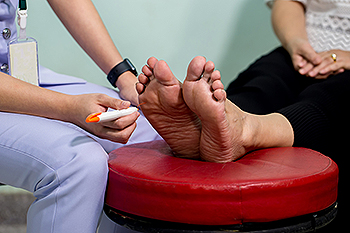Blog
Running and Foot Pain

Most runners experience pain in their feet from time to time. While some discomfort can subside on its own, other times more attention must be given to the problem to determine the source and severity of pain. Some causes of foot pain among runners are blisters, a toenail turning black from repetitive activity, and stress fractures. Oftentimes improperly fitting shoes–such as those that are too tight, too loose, or that have insufficient toe box room–are the culprit in running injuries. Beyond careful attention paid to well-fitting footwear, other simple measures that can be taken to prevent runner’s foot pain include using orthotics or running insoles, checking for proper running form, and stretching before and after running. Because runners' injuries can worsen and lead to more severe problems, it is suggested that a podiatrist be consulted if one is experiencing any prolonged foot pain.
All runners should take extra precaution when trying to avoid injury. If you have any concerns about your feet, contact Dr. Kendall Blackwell of InStride Wilson Podiatry Associates. Our doctor will treat your foot and ankle needs.
How to Prevent Running Injuries
There are a lot of mistakes a runner can make prior to a workout that can induce injury. A lot of athletes tend to overstretch before running, instead of saving those workouts for a post-run routine. Deep lunges and hand-to-toe hamstring pulls should be performed after a workout instead of during a warmup. Another common mistake is jumping into an intense routine before your body is physically prepared for it. You should try to ease your way into long-distance running instead of forcing yourself to rush into it.
More Tips for Preventing Injury
- Incorporate Strength Training into Workouts - This will help improve the body’s overall athleticism
- Improve and Maintain Your Flexibility – Stretching everyday will help improve overall performance
- “Warm Up” Before Running and “Cool Down” Afterward – A warm up of 5-10 minutes helps get rid of lactic acid in the muscles and prevents delayed muscle soreness
- Cross-Training is Crucial
- Wear Proper Running Shoes
- Have a Formal Gait Analysis – Poor biomechanics can easily cause injury
If you have any questions, please feel free to contact our office located in Wilson, NC . We offer the newest diagnostic and treatment technologies for all your foot care needs.
Foot Pain Can Come From Sporting Activities
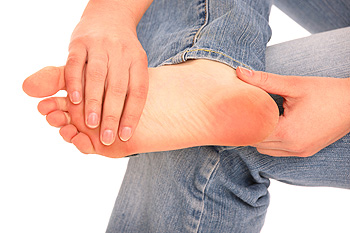
Young athletes may be prone to developing foot pain for various reasons. It may develop as a result of engaging in specific types of sporting activities that involve running and jumping. Foot injuries that happen gradually can include stress fractures and tendonitis and can produce a considerable amount of pain. Acute injuries can consist of a fracture, sprain, or bruise, and can cause severe pain and discomfort. Many people who endure this type of injury often need to have an X-ray taken, which can provide a proper diagnosis. There are methods that can be implemented which may help to prevent foot pain. These can include wearing shoes that fit correctly and replacing them approximately every three to four hundred miles. If your child has foot pain and is active in sports, please confer with a podiatrist who can recommend the correct treatment techniques.
Foot Pain
Foot pain can be extremely painful and debilitating. If you have a foot pain, consult with Dr. Kendall Blackwell from InStride Wilson Podiatry Associates. Our doctor will assess your condition and provide you with quality foot and ankle treatment.
Causes
Foot pain is a very broad condition that could be caused by one or more ailments. The most common include:
- Bunions
- Hammertoes
- Plantar Fasciitis
- Bone Spurs
- Corns
- Tarsal Tunnel Syndrome
- Ingrown Toenails
- Arthritis (such as Gout, Rheumatoid, and Osteoarthritis)
- Flat Feet
- Injury (from stress fractures, broken toe, foot, ankle, Achilles tendon ruptures, and sprains)
- And more
Diagnosis
To figure out the cause of foot pain, podiatrists utilize several different methods. This can range from simple visual inspections and sensation tests to X-rays and MRI scans. Prior medical history, family medical history, and any recent physical traumatic events will all be taken into consideration for a proper diagnosis.
Treatment
Treatment depends upon the cause of the foot pain. Whether it is resting, staying off the foot, or having surgery; podiatrists have a number of treatment options available for foot pain.
If you have any questions, please feel free to contact our office located in Wilson, NC . We offer the newest diagnostic and treatment technologies for all your foot care needs.
Causes of Plantar Fasciitis
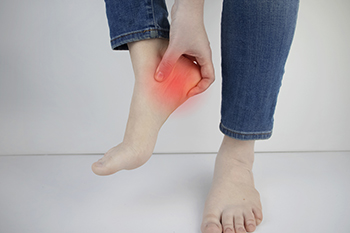 The band of tissue located on the bottom of the foot is known as the plantar fascia. Its function is to connect the toes to the heel, and plantar fasciitis can develop when this tissue becomes irritated. It may be caused by obesity, wearing shoes that do not fit correctly, or if an injury has occurred. The pain associated with plantar fasciitis is typically felt on the bottom of the foot, often making it painful to walk. Many patients notice that discomfort is more severe in the morning after arising but may feel better when the foot is elevated. Additional reasons why this condition may occur include standing for long periods of time, a recent change in activities, or other conditions, such as flat feet or high arches. Mild relief may be found by performing specific stretches that can strengthen the foot muscles. These include grabbing a towel with the toes and dragging it across the floor. Patients who have plantar fasciitis are wise to be under the care of a podiatrist who can offer correct treatment techniques that can provide permanent relief.
The band of tissue located on the bottom of the foot is known as the plantar fascia. Its function is to connect the toes to the heel, and plantar fasciitis can develop when this tissue becomes irritated. It may be caused by obesity, wearing shoes that do not fit correctly, or if an injury has occurred. The pain associated with plantar fasciitis is typically felt on the bottom of the foot, often making it painful to walk. Many patients notice that discomfort is more severe in the morning after arising but may feel better when the foot is elevated. Additional reasons why this condition may occur include standing for long periods of time, a recent change in activities, or other conditions, such as flat feet or high arches. Mild relief may be found by performing specific stretches that can strengthen the foot muscles. These include grabbing a towel with the toes and dragging it across the floor. Patients who have plantar fasciitis are wise to be under the care of a podiatrist who can offer correct treatment techniques that can provide permanent relief.
Plantar fasciitis can be very painful and inconvenient. If you are experiencing heel pain or symptoms of plantar fasciitis, contact Dr. Kendall Blackwell from InStride Wilson Podiatry Associates. Our doctor can provide the care you need to keep you pain-free and on your feet.
What Is Plantar Fasciitis?
Plantar fasciitis is the inflammation of the thick band of tissue that runs along the bottom of your foot, known as the plantar fascia, and causes mild to severe heel pain.
What Causes Plantar Fasciitis?
- Excessive running
- Non-supportive shoes
- Overpronation
- Repeated stretching and tearing of the plantar fascia
How Can It Be Treated?
- Conservative measures – anti-inflammatories, ice packs, stretching exercises, physical therapy, orthotic devices
- Shockwave therapy – sound waves are sent to the affected area to facilitate healing and are usually used for chronic cases of plantar fasciitis
- Surgery – usually only used as a last resort when all else fails. The plantar fascia can be surgically detached from the heel
While very treatable, plantar fasciitis is definitely not something that should be ignored. Especially in severe cases, speaking to your doctor right away is highly recommended to avoid complications and severe heel pain. Your podiatrist can work with you to provide the appropriate treatment options tailored to your condition.
If you have any questions please feel free to contact our office located in Wilson, NC . We offer the newest diagnostic and treatment technologies for all your foot and ankle needs.
How People With Diabetes Can Help Prevent Falls
Staying healthy and fit as you age will help you avoid falling. This is particularly important for people with diabetes, whose balance can be compromised from complications such as peripheral neuropathy (nerve damage), hypoglycemia, diabetic retinopathy (vision problems), as well as joint pain, and osteoporosis (bone damage). If you are experiencing balance issues or pain that is affecting your mobility, consult with a podiatrist who may be able to prescribe diabetic shoes and/or custom orthotics that will offer better support and alignment, to help you walk better. You can also discuss the possibility of improving your balance by strengthening your muscles and maintaining bone density with various gentle forms of exercise and physical therapy. Your podiatrist can also offer various forms of treatment to help relieve symptoms of peripheral neuropathy.
Preventing falls among the elderly is very important. If you are older and have fallen or fear that you are prone to falling, consult with Dr. Kendall Blackwell from InStride Wilson Podiatry Associates. Our doctor will assess your condition and provide you with quality advice and care.
Every 11 seconds, an elderly American is being treated in an emergency room for a fall related injury. Falls are the leading cause of head and hip injuries for those 65 and older. Due to decreases in strength, balance, senses, and lack of awareness, elderly persons are very susceptible to falling. Thankfully, there are a number of things older persons can do to prevent falls.
How to Prevent Falls
Some effective methods that older persons can do to prevent falls include:
- Enrolling in strength and balance exercise program to increase balance and strength
- Periodically having your sight and hearing checked
- Discuss any medications you have with a doctor to see if it increases the risk of falling
- Clearing the house of falling hazards and installing devices like grab bars and railings
- Utilizing a walker or cane
- Wearing shoes that provide good support and cushioning
- Talking to family members about falling and increasing awareness
Falling can be a traumatic and embarrassing experience for elderly persons; this can make them less willing to leave the house, and less willing to talk to someone about their fears of falling. Doing such things, however, will increase the likelihood of tripping or losing one’s balance. Knowing the causes of falling and how to prevent them is the best way to mitigate the risk of serious injury.
If you have any questions, please feel free to contact our office located in Wilson, NC . We offer the newest diagnostic and treatment technologies for all your foot care needs.
Gout Pain Can Be Managed
What Are Heel Spurs?
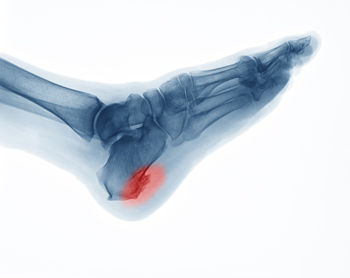 Heel spurs, or “enthesophytes,” develop on the heel of the foot. There are two types of heel spurs associated with different heel problems. One type of heel spur is called a Plantar Spur. It is linked to a problem called “Heel Spur Syndrome” and is a bone spur that develops on the bottom of the heel, on the sole of the foot where the plantar fascia (a band of fibrous tissue that stretches along the bottom of the foot) connects to the heel bone. People who have plantar fasciitis are prone to developing these kinds of spurs, which are the bone’s response to stress from straining foot muscles and ligaments, overstretching the plantar fascia, or repeated tearing of the thin lining of the heel bone. They are also associated with age, obesity, and osteoarthritis. Heel spurs are less likely to feel painful. The other type of heel spur is a Dorsal Spur and is connected to a problem called “Insertional Achilles Tendonitis,” a condition where a bone spur develops at the back of the heel, where the Achilles tendon fits into the bone. If you notice a bony protrusion on the heel of your foot or have pain in this area, it is best to consult with a podiatrist who can diagnose the problem and recommend proper treatment.
Heel spurs, or “enthesophytes,” develop on the heel of the foot. There are two types of heel spurs associated with different heel problems. One type of heel spur is called a Plantar Spur. It is linked to a problem called “Heel Spur Syndrome” and is a bone spur that develops on the bottom of the heel, on the sole of the foot where the plantar fascia (a band of fibrous tissue that stretches along the bottom of the foot) connects to the heel bone. People who have plantar fasciitis are prone to developing these kinds of spurs, which are the bone’s response to stress from straining foot muscles and ligaments, overstretching the plantar fascia, or repeated tearing of the thin lining of the heel bone. They are also associated with age, obesity, and osteoarthritis. Heel spurs are less likely to feel painful. The other type of heel spur is a Dorsal Spur and is connected to a problem called “Insertional Achilles Tendonitis,” a condition where a bone spur develops at the back of the heel, where the Achilles tendon fits into the bone. If you notice a bony protrusion on the heel of your foot or have pain in this area, it is best to consult with a podiatrist who can diagnose the problem and recommend proper treatment.
Heel spurs can be incredibly painful and sometimes may make you unable to participate in physical activities. To get medical care for your heel spurs, contact Dr. Kendall Blackwell from InStride Wilson Podiatry Associates. Our doctor will do everything possible to treat your condition.
Heels Spurs
Heel spurs are formed by calcium deposits on the back of the foot where the heel is. This can also be caused by small fragments of bone breaking off one section of the foot, attaching onto the back of the foot. Heel spurs can also be bone growth on the back of the foot and may grow in the direction of the arch of the foot.
Older individuals usually suffer from heel spurs and pain sometimes intensifies with age. One of the main condition's spurs are related to is plantar fasciitis.
Pain
The pain associated with spurs is often because of weight placed on the feet. When someone is walking, their entire weight is concentrated on the feet. Bone spurs then have the tendency to affect other bones and tissues around the foot. As the pain continues, the feet will become tender and sensitive over time.
Treatments
There are many ways to treat heel spurs. If one is suffering from heel spurs in conjunction with pain, there are several methods for healing. Medication, surgery, and herbal care are some options.
If you have any questions feel free to contact our office located in Wilson, NC . We offer the latest in diagnostic and treatment technology to meet your needs.
Can Hammertoe be Corrected?
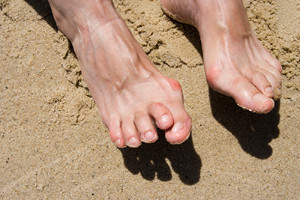 The most common symptom of hammertoe is when the toe(s) bends or curls downward instead of pointing forward. This deformity can occur as a result of having arthritis, wearing shoes that do not fit correctly, or from a toe injury. Patients can develop this condition from genetic factors or from having corns or bunions. Hammertoe can cause difficulty in walking, and it may cause pain when the toes are wiggled. A proper diagnosis is necessary in determining the severity of the condition. This is accomplished by performing a physical examination or by having an X-ray taken. Mild relief may be found when a protective covering is worn over the affected toe. Additionally, surgery may be necessary if the toe is unable to move. Surgery can be successful in restoring full range of motion, realigning the tendons and joints, and to remove the injured or deformed bone. If you have a hammertoe, it is suggested that you consult with a podiatrist who can offer proper treatment solutions.
The most common symptom of hammertoe is when the toe(s) bends or curls downward instead of pointing forward. This deformity can occur as a result of having arthritis, wearing shoes that do not fit correctly, or from a toe injury. Patients can develop this condition from genetic factors or from having corns or bunions. Hammertoe can cause difficulty in walking, and it may cause pain when the toes are wiggled. A proper diagnosis is necessary in determining the severity of the condition. This is accomplished by performing a physical examination or by having an X-ray taken. Mild relief may be found when a protective covering is worn over the affected toe. Additionally, surgery may be necessary if the toe is unable to move. Surgery can be successful in restoring full range of motion, realigning the tendons and joints, and to remove the injured or deformed bone. If you have a hammertoe, it is suggested that you consult with a podiatrist who can offer proper treatment solutions.
Hammertoes can be a painful condition to live with. For more information, contact Dr. Kendall Blackwell of InStride Wilson Podiatry Associates. Our doctor will answer any of your foot- and ankle-related questions.
Hammertoe
Hammertoe is a foot deformity that occurs due to an imbalance in the muscles, tendons, or ligaments that normally hold the toe straight. It can be caused by the type of shoes you wear, your foot structure, trauma, and certain disease processes.
Symptoms
- Painful and/or difficult toe movement
- Swelling
- Joint stiffness
- Calluses/Corns
- Physical deformity
Risk Factors
- Age – The risk of hammertoe increases with age
- Sex – Women are more likely to have hammertoe compared to men
- Toe Length – You are more likely to develop hammertoe if your second toe is longer than your big toe
- Certain Diseases – Arthritis and diabetes may make you more likely to develop hammertoe
Treatment
If you have hammertoe, you should change into a more comfortable shoe that provides enough room for your toes. Exercises such as picking up marbles may strengthen and stretch your toe muscles. Nevertheless, it is important to seek assistance from a podiatrist in order to determine the severity of your hammertoe and see which treatment option will work best for you.
If you have any questions, please feel free to contact our office located in Wilson, NC . We offer the newest diagnostic and treatment technologies for all your foot care needs.
What Is Sesamoiditis and What Does It Have to Do With My Feet?
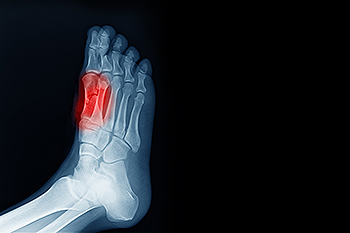 Sesamoiditis is when the tendons attached to the sesamoids (bones connected by tendons to muscles) become inflamed. While the kneecap is the biggest sesamoid in the body, there are smaller sesamoids near the big toe on the bottom of the foot. Sesamoiditis is the term most often used to describe this condition in reference to the foot, and tendonitis is more likely to be used when related to the kneecap. Sesamoiditis can develop from overuse or trauma of the tendons connected to small bones in the front of the foot. Athletes, dancers, and those who wear high heels or improperly fitting shoes are more often plagued by this disorder. Pain usually occurs slowly under the ball of the foot, and swelling or bruising may be noticed. The big toe may become immobile, and there can be a popping sensation when walking. It is a good idea to consult a podiatrist, who can examine and diagnose the affected foot using an X-ray, a bone scan, an ultrasound, or an MRI. While orthotics and anti-inflammatory medications may be suggested, sesamoiditis can often heal with rest and be prevented with lifestyle changes. Surgery is a last resort.
Sesamoiditis is when the tendons attached to the sesamoids (bones connected by tendons to muscles) become inflamed. While the kneecap is the biggest sesamoid in the body, there are smaller sesamoids near the big toe on the bottom of the foot. Sesamoiditis is the term most often used to describe this condition in reference to the foot, and tendonitis is more likely to be used when related to the kneecap. Sesamoiditis can develop from overuse or trauma of the tendons connected to small bones in the front of the foot. Athletes, dancers, and those who wear high heels or improperly fitting shoes are more often plagued by this disorder. Pain usually occurs slowly under the ball of the foot, and swelling or bruising may be noticed. The big toe may become immobile, and there can be a popping sensation when walking. It is a good idea to consult a podiatrist, who can examine and diagnose the affected foot using an X-ray, a bone scan, an ultrasound, or an MRI. While orthotics and anti-inflammatory medications may be suggested, sesamoiditis can often heal with rest and be prevented with lifestyle changes. Surgery is a last resort.
Sesamoiditis is an unpleasant foot condition characterized by pain in the balls of the feet. If you think you’re struggling with sesamoiditis, contact Dr. Kendall Blackwell of InStride Wilson Podiatry Associates. Our doctor will treat your condition thoroughly and effectively.
Sesamoiditis
Sesamoiditis is a condition of the foot that affects the ball of the foot. It is more common in younger people than it is in older people. It can also occur with people who have begun a new exercise program, since their bodies are adjusting to the new physical regimen. Pain may also be caused by the inflammation of tendons surrounding the bones. It is important to seek treatment in its early stages because if you ignore the pain, this condition can lead to more serious problems such as severe irritation and bone fractures.
Causes of Sesamoiditis
- Sudden increase in activity
- Increase in physically strenuous movement without a proper warm up or build up
- Foot structure: those who have smaller, bonier feet or those with a high arch may be more susceptible
Treatment for sesamoiditis is non-invasive and simple. Doctors may recommend a strict rest period where the patient forgoes most physical activity. This will help give the patient time to heal their feet through limited activity. For serious cases, it is best to speak with your doctor to determine a treatment option that will help your specific needs.
If you have any questions please feel free to contact our office located in Wilson, NC . We offer the newest diagnostic and treatment technologies for all your foot and ankle needs.
What Podiatrists Can Do for Ankle Sprains
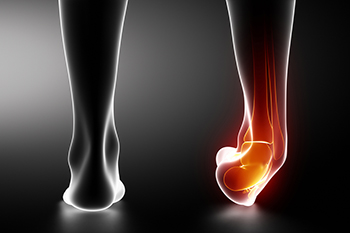 Ankle sprains are one of the most common injuries to occur when playing sports. They occur when the ligaments that connect the bones to the joints become over stretched or torn because of a sudden twist or force. Signs of an ankle sprain include ankle swelling, bruising, pain, difficulty bending the ankle, or difficulty bearing weight with the ankle. Patients who are unable to walk with their injured ankle, have significant swelling, or haven’t seen any signs of progress after a few days, should consult with a podiatrist for treatment. Ultimately, differentiating between an ankle sprain and an ankle fracture can be very difficult. Therefore, patients who believe that they have sprained their ankle should consult with a podiatrist who can evaluate and diagnose the injury.
Ankle sprains are one of the most common injuries to occur when playing sports. They occur when the ligaments that connect the bones to the joints become over stretched or torn because of a sudden twist or force. Signs of an ankle sprain include ankle swelling, bruising, pain, difficulty bending the ankle, or difficulty bearing weight with the ankle. Patients who are unable to walk with their injured ankle, have significant swelling, or haven’t seen any signs of progress after a few days, should consult with a podiatrist for treatment. Ultimately, differentiating between an ankle sprain and an ankle fracture can be very difficult. Therefore, patients who believe that they have sprained their ankle should consult with a podiatrist who can evaluate and diagnose the injury.
Ankle sprains are common but need immediate attention. If you need your feet checked, contact Dr. Kendall Blackwell from InStride Wilson Podiatry Associates. Our doctor can provide the care you need to keep you pain-free and on your feet.
How Does an Ankle Sprain Occur?
Ankle sprains take place when the ligaments in your ankle are torn or stretched beyond their limits. There are multiple ways that the ankle can become injured, including twisting or rolling over onto your ankle, putting undue stress on it, or causing trauma to the ankle itself.
What Are the Symptoms?
- Mild to moderate bruising
- Limited mobility
- Swelling
- Discoloration of the skin (depending on severity)
Preventing a Sprain
- Wearing appropriate shoes for the occasion
- Stretching before exercises and sports
- Knowing your limits
Treatment of a Sprain
Treatment of a sprain depends on the severity. Many times, people are told to rest and remain off their feet completely, while others are given an air cast. If the sprain is very severe, surgery may be required.
If you have suffered an ankle sprain previously, you may want to consider additional support such as a brace and regular exercises to strengthen the ankle.
If you have any questions please feel free to contact our office located in Wilson, NC . We offer the newest diagnostic and treatment technologies for all your foot and ankle needs.
Are Bunions Affecting Your Everyday Life?
More...
Causes and Remedies for Cold Feet
If you have cold feet on a regular basis, there may be a variety of causes. Sometimes, your feet are cold simply because of the temperature. Cold weather makes the blood vessels in the extremities constrict to help keep your vital organs warm. The same effect can be caused by high anxiety or stress. By far the most common cause of chronic cold feet is poor circulation. Lifestyle choices, such as being sedentary, sitting at a desk all day, or smoking often inhibit blood flow to your feet. Additional factors, such as high cholesterol, which works to restrict the arterial flow of blood, can result in poor circulation. Other causes include diabetes, anemia, nerve disorders and hypothyroidism. Anyone who experiences cold feet regularly would be wise to visit with a podiatrist who can diagnose their condition and prescribe proper treatment options. In the meantime, you can put on warm socks and slippers, take foot baths regularly, and take short walks to help get the blood flowing.
Poor circulation is a serious condition and needs immediate medical attention. If you have any concerns with poor circulation in your feet contact Dr. Kendall Blackwell of InStride Wilson Podiatry Associates. Our doctor will treat your foot and ankle needs.
Poor Circulation in the Feet
Poor blood circulation in the feet and legs is can be caused by peripheral artery disease (PAD), which is the result of a buildup of plaque in the arteries.
Plaque buildup or atherosclerosis results from excess calcium and cholesterol in the bloodstream. This can restrict the amount of blood which can flow through the arteries. Poor blood circulation in the feet and legs are sometimes caused by inflammation in the blood vessels, known as vasculitis.
Causes
Lack of oxygen and oxygen from poor blood circulation restricts muscle growth and development. It can also cause:
- Muscle pain, stiffness, or weakness
- Numbness or cramping in the legs
- Skin discoloration
- Slower nail & hair growth
- Erectile dysfunction
Those who have diabetes or smoke are at greatest risk for poor circulation, as are those who are over 50. If you have poor circulation in the feet and legs it may be caused by PAD and is important to make changes to your lifestyle in order to reduce risk of getting a heart attack or stroke. Exercise and maintaining a healthy lifestyle will dramatically improve conditions.
As always, see a podiatrist as he or she will assist in finding a regimen that suits you. A podiatrist can also prescribe you any needed medication.
If you have any questions please feel free to contact our office located in Wilson, NC . We offer the newest diagnostic and treatment technologies for all your foot and ankle needs.
How Common Are Flat Feet?
Flat feet, the condition in which the arches in the center of the sole of the foot are absent when the feet are bearing weight, is quite common. Approximately 8% of adults in the United States have congenital flat feet, which occur when the arches fail to form during early childhood. An additional 4% have fallen arches, flat feet that are acquired due to a preexisting arch collapsing over time. While congenital flat feet are usually asymptomatic, fallen arches can often cause foot pain, cramping, and fatigue. Both people who have flat feet from birth and those who have acquired them over time may have an overpronated gait, a pattern of foot movement in which the feet roll too far inwards while walking. If you have flat feet and foot pain that is bothering you, it is suggested that you see a podiatrist for treatment.
Flatfoot is a condition many people suffer from. If you have flat feet, contact Dr. Kendall Blackwell from InStride Wilson Podiatry Associates. Our doctor will treat your foot and ankle needs.
What Are Flat Feet?
Flatfoot is a condition in which the arch of the foot is depressed and the sole of the foot is almost completely in contact with the ground. About 20-30% of the population generally has flat feet because their arches never formed during growth.
Conditions & Problems:
Having flat feet makes it difficult to run or walk because of the stress placed on the ankles.
Alignment – The general alignment of your legs can be disrupted, because the ankles move inward which can cause major discomfort.
Knees – If you have complications with your knees, flat feet can be a contributor to arthritis in that area.
Symptoms
- Pain around the heel or arch area
- Trouble standing on the tip toe
- Swelling around the inside of the ankle
- Flat look to one or both feet
- Having your shoes feel uneven when worn
Treatment
If you are experiencing pain and stress on the foot you may weaken the posterior tibial tendon, which runs around the inside of the ankle.
If you have any questions please feel free to contact our office located in Wilson, NC . We offer the newest diagnostic and treatment technologies for all your foot and ankle needs.
Treating Peripheral Neuropathy
Peripheral neuropathy occurs when nerves in the extremities become damaged and dysfunctional. Peripheral neuropathy can cause numbness, tingling, burning/shooting pains and muscle weakness in the feet, along with cramps, swelling, sensitivity, and a loss of coordination and balance. This condition often makes it difficult for people to walk. Peripheral neuropathy is often caused by the elevated sugar levels associated with diabetes, but may also occur due to viral infections, injury, or as a side effect of taking certain medications or indulging in too much alcohol. A podiatrist can help treat peripheral neuropathy through pharmaceutical and physical therapy, custom orthotics for your shoes, or even nerve stimulation treatments. It is suggested that you call a podiatrist to explore treatment options for your peripheral neuropathy.
Neuropathy
Neuropathy can be a potentially serious condition, especially if it is left undiagnosed. If you have any concerns that you may be experiencing nerve loss in your feet, consult with Dr. Kendall Blackwell from InStride Wilson Podiatry Associates. Our doctor will assess your condition and provide you with quality foot and ankle treatment for neuropathy.
What Is Neuropathy?
Neuropathy is a condition that leads to damage to the nerves in the body. Peripheral neuropathy, or neuropathy that affects your peripheral nervous system, usually occurs in the feet. Neuropathy can be triggered by a number of different causes. Such causes include diabetes, infections, cancers, disorders, and toxic substances.
Symptoms of Neuropathy Include:
- Numbness
- Sensation loss
- Prickling and tingling sensations
- Throbbing, freezing, burning pains
- Muscle weakness
Those with diabetes are at serious risk due to being unable to feel an ulcer on their feet. Diabetics usually also suffer from poor blood circulation. This can lead to the wound not healing, infections occurring, and the limb may have to be amputated.
Treatment
To treat neuropathy in the foot, podiatrists will first diagnose the cause of the neuropathy. Figuring out the underlying cause of the neuropathy will allow the podiatrist to prescribe the best treatment, whether it be caused by diabetes, toxic substance exposure, infection, etc. If the nerve has not died, then it’s possible that sensation may be able to return to the foot.
Pain medication may be issued for pain. Electrical nerve stimulation can be used to stimulate nerves. If the neuropathy is caused from pressure on the nerves, then surgery may be necessary.
If you have any questions, please feel free to contact our office located in Wilson, NC . We offer the newest diagnostic and treatment technologies for all your foot care needs.





